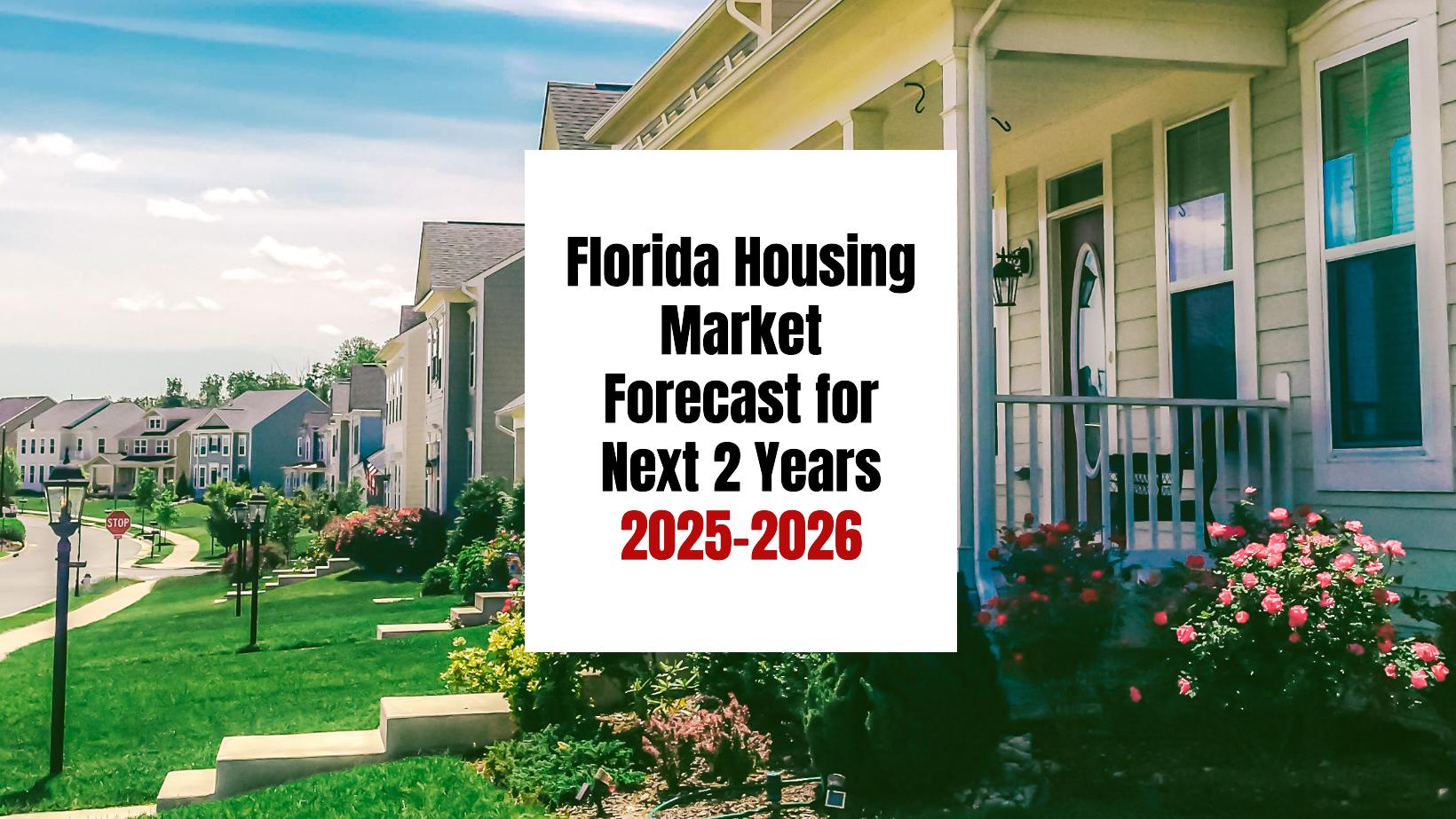Florida Housing Market Forecast for Next 2 Years: 2025-2026
The Florida housing market has always been a topic of interest for buyers, sellers, and investors alike. With its sunny beaches, vibrant cities, and booming tourism industry, the real estate market in the Sunshine State has seen significant growth over the years. However, with any market experiencing rapid growth, there comes the question of sustainability and the potential for a downturn.
Is Florida’s housing market predicted to crash in the next two years? Experts say no. While growth may slow due to rising interest rates, Florida’s demographics and rebound predictions suggest a market with staying power. Here are the latest trends in Florida’s housing market.
Florida Housing Market Forecast for Next 2 Years: 2025-2026
As we look towards the forecast for 2025-2026, it’s important to consider various factors that influence the housing market. According to recent reports, the Florida housing market is expected to continue its positive trend in the coming years, albeit at a potentially slower pace. The state has witnessed an approximate 80% rise in home values over the past five years, and this upward trajectory is forecasted to persist.
Current Market Trends
Here’s a quick overview of what the numbers are telling us about the Florida real estate market:
- Increased Listings: New listings of single-family homes jumped by 15.4% year-over-year. Condo and townhouse listings saw an even bigger surge, setting a record for the most in a single month since tracking began in 2008.
- Rising Inventory: Inventory for both single-family homes and condo-townhouse units is up significantly, increasing by 31.3% and 39.3% respectively.
- Sales Trends: Single-family home sales are slightly up (3.6%), while condo-townhouse sales are down (3.7%) compared to January 2024.
- Median Sales Prices: Single-family home prices are up slightly (1.2%), but condo-townhouse prices have decreased (2.3%) year-over-year.
- Months’ Supply: The supply of single-family homes sits at 5.1 months, while condo-townhouse supply is at 9.1 months.
Diving Deeper: The Numbers Behind the Trends
Let’s get into the details of these trends and analyze what they mean for you.
The Surge in New Listings: A Breath of Fresh Air?
Dr. Brad O’Connor, Chief Economist at Florida Realtors®, rightly points out that January typically sees a surge in new listings. This year, however, the jump is particularly noteworthy. The increase in both single-family and condo/townhouse listings is injecting much-needed inventory into the market.
For buyers, this means more choices and potentially less competition. For sellers, it means they need to be strategic in pricing and marketing their properties to stand out from the crowd.
Inventory on the Rise: A Shift in Power?
The rise in inventory is perhaps the most significant trend right now. For the past few years, Florida has been grappling with a severe inventory shortage, which drove up prices and made it difficult for buyers to find a home. The fact that inventory is now increasing suggests a shift in the balance of power, moving slightly towards buyers.
However, O’Connor’s caution is warranted. We need to monitor inventory levels throughout the spring buying season to see if this trend continues. If it does, we might see more sellers becoming willing to negotiate on price.
Sales and Prices: A Mixed Bag
The sales data paints a mixed picture. While single-family home sales are up, condo-townhouse sales are down. This could be due to a variety of factors, including changing preferences, affordability concerns, and the type of inventory available.
The slight increase in single-family home prices and decrease in condo-townhouse prices also highlight the varying dynamics within the market. It’s crucial to understand that “Florida” is not a monolithic market; conditions can vary significantly from one city or county to another.
Understanding “Months’ Supply”
The months’ supply metric is crucial for understanding market dynamics. It indicates how long it would take to sell all the existing homes on the market at the current sales rate. A balanced market typically has a 5-6 month supply.
- 5.1 months’ supply for single-family homes indicates a relatively balanced market, leaning slightly towards sellers.
- 9.1 months’ supply for condo-townhouse properties suggests a buyer’s market, with more properties available than buyers.
CoreLogic’s High-Risk Markets: A Cause for Concern?
Now, let’s address a potentially worrying aspect of the Florida real estate market: CoreLogic’s assessment of high-risk markets. CoreLogic identifies markets with a “very high” risk (over 70% probability) of price decline. According to their January 2025 data, three Florida markets fall into this category:
| Rank | City | State | Risk Level |
|---|---|---|---|
| 1 | Tampa | FL | Very High |
| 2 | Tucson | AZ | Very High |
| 3 | West Palm Beach | FL | Very High |
| 4 | Winter Haven | FL | Very High |
| 5 | Phoenix | AZ | Very High |
The presence of Tampa, West Palm Beach, and Winter Haven on this list should raise eyebrows. It suggests that these markets may be overvalued and susceptible to a correction.
What factors contribute to this risk?
- Rapid Price Appreciation: These markets have seen significant price increases in recent years, potentially outpacing income growth and creating an unsustainable bubble.
- Overbuilding: Excessive construction of new homes can lead to an oversupply, putting downward pressure on prices.
- Economic Vulnerability: Markets heavily reliant on tourism or specific industries can be more vulnerable to economic downturns.
- Interest Rate Sensitivity: Rising interest rates can impact affordability and dampen demand, particularly in markets with high levels of mortgage debt.
What does this mean for buyers and sellers?
- Buyers: In these high-risk markets, exercise caution and conduct thorough due diligence. Consider whether the current prices are justified and if you can afford the property if prices decline.
- Sellers: If you’re considering selling in one of these markets, it might be wise to act sooner rather than later. Pricing your property competitively and marketing it effectively is crucial.
Mortgage Rates, Home Prices, and Median Incomes: The Affordability Equation
Tim Weisheyer, President of Florida Realtors®, rightly points out that home sales are still affected by the interplay of mortgage rates, home prices, and median incomes. Affordability remains a major challenge for many Floridians.
High mortgage rates increase the cost of borrowing, making it more difficult for buyers to qualify for a loan. High home prices further exacerbate the problem, while stagnant or slow-growing median incomes make it even harder for families to afford a home.
The Role of Realtors®
In times like these, the expertise of a local Realtor® is more valuable than ever. They can provide invaluable guidance to both buyers and sellers, helping them navigate the complexities of the market and achieve their real estate goals. Realtors® can offer insights into local market conditions, negotiate on your behalf, and ensure a smooth and successful transaction.
Florida Housing Market Predictions for 2025
Predicting the future of the real estate market is always challenging, but here are some trends I expect to see continue in the coming months:
- Inventory Levels: I expect inventory levels to continue to rise, potentially leading to a more balanced market.
- Mortgage Rates: Mortgage rates will likely remain volatile, influenced by economic data and Federal Reserve policy.
- Affordability: Affordability will continue to be a major concern, impacting buyer demand and sales activity.
- Regional Variations: Market conditions will continue to vary significantly from one region to another.
- Increased Scrutiny on High-Risk Markets – I would not be surprised to see home values in Tampa, West Palm Beach, and Winter Haven flatten out or even decline slightly as these markets correct themselves.
Florida Housing Market Predictions for 2026
Continued Growth Amid Stabilization
- Sustained Appreciation: By 2026, the market is expected to see a return to more normalized appreciation rates, with home values likely increasing by 3% to 5% annually. This growth will be underpinned by the state’s strong demographic trends and economic fundamentals.
- Market Dynamics: The housing market may begin to thaw, with increased sales activity as mortgage rates decline and inventory levels stabilize. The competition for homes is expected to rise, although it may not reach the frenetic levels seen in previous years.
- Rental Market Trends: The rental market is projected to experience a more moderate growth trajectory. While single-family home rents may rise faster than multifamily units, overall rental growth is expected to align more closely with inflation rates by 2026.
- Potential Challenges: Despite positive indicators, challenges such as high mortgage rates and potential economic fluctuations could still impact buyer sentiment and market dynamics. Localized downturns may occur in areas that have seen significant price increases in recent years.
Takeaway: In summary, the Florida housing market is anticipated to stabilize in 2025, with gradual price appreciation returning by 2026, supported by strong demographic trends and a recovering economy. However, the market will continue to face challenges related to mortgage rates and economic conditions.
While the Florida housing market may experience fluctuations and a potential stabilization in growth rates, a crash seems unlikely in the next two years. The combination of economic fundamentals, population growth, and the state’s inherent appeal suggests a market that will continue to attract interest and investment. For those considering entering the Florida real estate market, staying informed and vigilant about market trends will be key to making sound decisions.
Work with Norada in 2025, Your Trusted Source for
Real Estate Investing in “Florida”
Discover high-quality, ready-to-rent properties designed to deliver consistent returns.
Contact us today to expand your real estate portfolio with confidence.
Contact our investment counselors (No Obligation):
(800) 611-3060
Get Started Now

.jpg)

